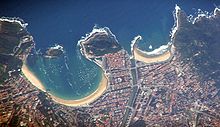Bay: Difference between revisions
m Reverted edits by 39.55.29.54 (talk) to last version by 117.245.150.215 |
No edit summary |
||
| Line 1: | Line 1: | ||
} |
|||
{{About|the geographical feature|other uses|Bay (disambiguation)}} |
|||
[[File:San Sebastian aerea.jpg|thumb|The bay at [[San Sebastián]], [[Spain]]]] |
[[File:San Sebastian aerea.jpg|thumb|The bay at [[San Sebastián]], [[Spain]]]] |
||
[[File:Bay of Bengal map.png|thumb|The [[Bay of Bengal]] in [[South Asia]]]] |
[[File:Bay of Bengal map.png|thumb|The [[Bay of Bengal]] in [[South Asia]]]] |
||
e bay of [[Baracoa]], [[Cuba]]]] |
|||
A '''bay''' is a large body of water connected to an ocean or sea formed by an inlet of land due to the surrounding land blocking some [[ocean surface wave|waves]] and often reducing [[winds]].<ref>{{cite web|title=http://www.yourdictionary.com/bay|url=http://www.yourdictionary.com/bay|accessdate=24 March 2012}}</ref> Bays also exist in in-land environments as an inlet to any larger body of water, such as a [[lake]] or [[pond]], or the [[estuary]] of a river, such as those found in and around the [[Great Lakes]] of [[North America]], or in the estuary of the [[Parramatta River]] in [[Australia]]. A large bay may be called a '''[[Gulf (geography)|gulf]]''', a '''[[sea]]''', a '''[[sound (geography)|sound]]''', or a '''[[bight (geography)|bight]]'''. A '''[[cove]]''' is a circular or [[oval]] [[coast]]al [[inlet]] with a narrow entrance; some coves may be referred to as bays. A '''[[fjord]]''' is a particularly steep bay shaped by glacial activity. |
A '''bay''' is a large body of water connected to an ocean or sea formed by an inlet of land due to the surrounding land blocking some [[ocean surface wave|waves]] and often reducing [[winds]].<ref>{{cite web|title=http://www.yourdictionary.com/bay|url=http://www.yourdictionary.com/bay|accessdate=24 March 2012}}</ref> Bays also exist in in-land environments as an inlet to any larger body of water, such as a [[lake]] or [[pond]], or the [[estuary]] of a river, such as those found in and around the [[Great Lakes]] of [[North America]], or in the estuary of the [[Parramatta River]] in [[Australia]]. A large bay may be called a '''[[Gulf (geography)|gulf]]''', a '''[[sea]]''', a '''[[sound (geography)|sound]]''', or a '''[[bight (geography)|bight]]'''. A '''[[cove]]''' is a circular or [[oval]] [[coast]]al [[inlet]] with a narrow entrance; some coves may be referred to as bays. A '''[[fjord]]''' is a particularly steep bay shaped by glacial activity. |
||
| Line 22: | Line 22: | ||
{{Coastal geography}} |
{{Coastal geography}} |
||
[[Categ |
|||
[[Category:Bays| ]] |
|||
[[Category:Bodies of water]] |
|||
[[Category:Coastal and oceanic landforms]] |
[[Category:Coastal and oceanic landforms]] |
||
[[Category:Coastal geography]] |
[[Category:Coastal geography]] |
||
Revision as of 00:42, 16 January 2014
}


e bay of Baracoa, Cuba]] A bay is a large body of water connected to an ocean or sea formed by an inlet of land due to the surrounding land blocking some waves and often reducing winds.[1] Bays also exist in in-land environments as an inlet to any larger body of water, such as a lake or pond, or the estuary of a river, such as those found in and around the Great Lakes of North America, or in the estuary of the Parramatta River in Australia. A large bay may be called a gulf, a sea, a sound, or a bight. A cove is a circular or oval coastal inlet with a narrow entrance; some coves may be referred to as bays. A fjord is a particularly steep bay shaped by glacial activity.
Bays were significant in the history of human settlement because they can provide a safe place for fishing. Later they were important in the development of sea trade as the safe anchorage they provide encouraged their selection as ports.[2] Any bay may contain fish and other sea creatures or be adjacent to other bays. For example, James Bay is adjacent to Hudson Bay. Large bays, such as the Bay of Bengal and the Hudson Bay, have varied marine geology.
Formation
There are various ways that bays can be created. The largest bays have developed as a result of continental drift.[2] As the super-continent Gondwana broke up along curved and indented fault lines, the continents moved apart and the world's largest bays formed. These include the Gulf of Guinea, Persian Gulf, Gulf of Alaska, Gulf of Mexico and the Bay of Bengal which is the largest bay in the world.[2]
Another way bays are formed is via glacial and river erosion.[2] If formed by glaciers a bay is known as a fjord. Rias are created by rivers and are characterised by more gradual slopes. Most gulf and bays are formed by the folding of the earth's crust as well as coastal erosion due to waves and currents.[2] Currents can make waves more constant, while soft rocks will allow erosion to have a stronger effect. Any hard rock is eroded less quickly, leaving headlands. The Gulf of California is an example of a bay created by the geological process of folding.
See also
References
[[Categ


